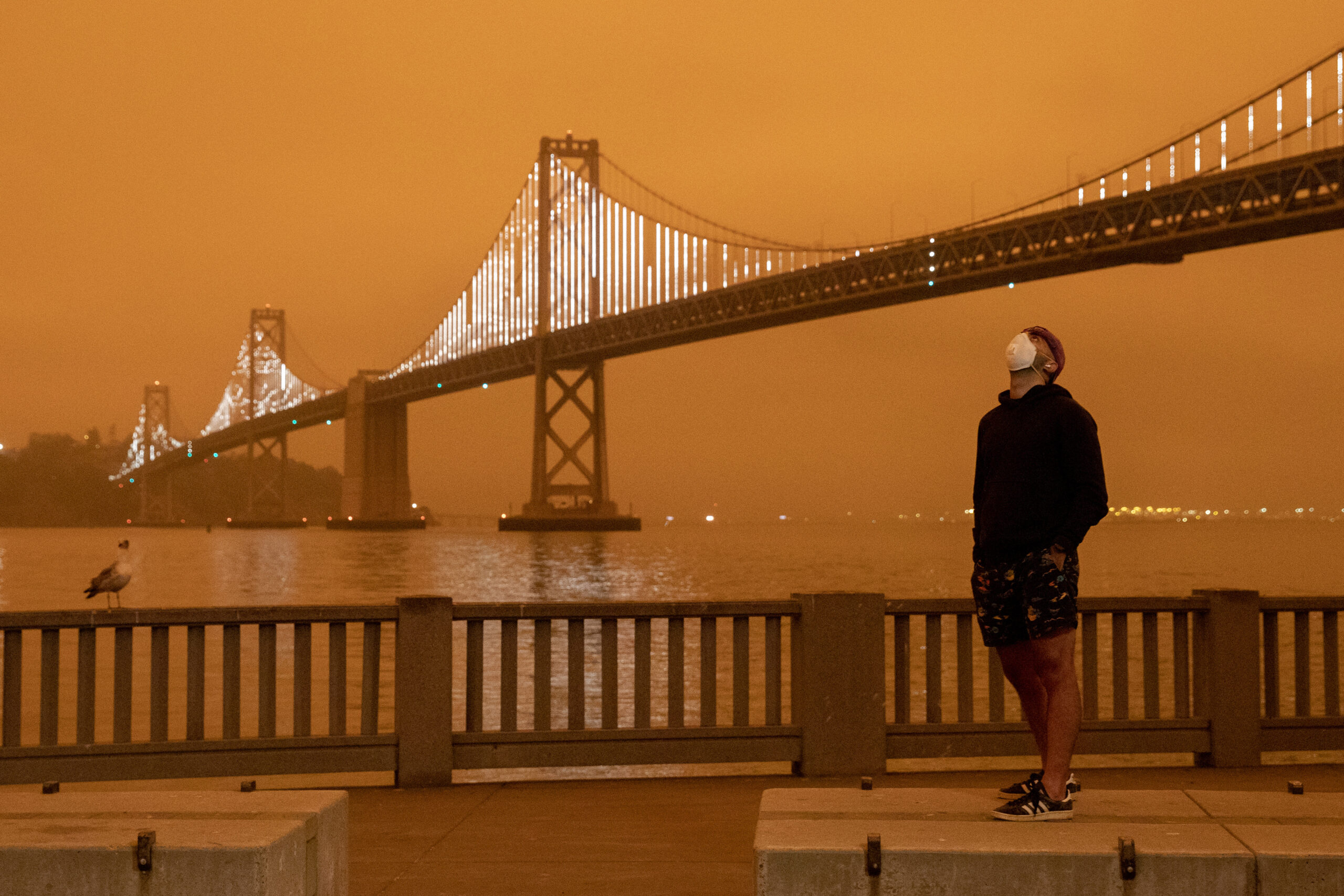Gallery of 2 photos
the slideshow
An air quality advisory was once again announced late Thursday evening—just hours before the anniversary of San Francisco’s infamous “Orange Day,” when smoke from record-setting California wildfires painted the city’s sky an apocalyptic hue.
The current warning was issued in anticipation of rising Air Quality Index (AQI) values over the weekend.
AQI in San Francisco on Thursday ranged between 40 and 141, with an average of 80, according to air quality tracker AirNow.gov.
AQI is a scale from 0 to over 500: zero reflects clear air quality while anything above 300 is deemed hazardous to the public’s health. An AQI value above 50 indicates “moderate” air quality.
Bay Area Air Quality says wildfires in California and Oregon are to blame, as smoke traveled into the Bay Area late Thursday evening and blanketed San Francisco with a light haze.
The Mosquito Fire erupted on Tuesday, following an unprecedented Labor Day weekend heat dome, and has quickly spread across nearly 30,000 acres in Northern California.
Extraordinary images of #MosquitoFire this evening. This one is going to be burning & producing large volumes of smoke for many days, so folks in NorCal and western Nevada should prepare for a potentially prolonged period of smoke-related air quality impacts. #CAwx #NVwx #CAfire pic.twitter.com/ljvMWRy4ws
— Dr. Daniel Swain (@Weather_West) September 9, 2022
Smoke is forecasted to linger on this weekend, and Bay Area Air Quality extended its air quality advisory through Saturday.
Northern counties closer to the fire’s origins are currently experiencing much higher AQI values, as smoke chokes inland areas in Roseville (AQI 117) and Placerville (AQI 358).
The sooty air may not be all bad for San Francisco, however.
The National Weather Service says that the smoke might actually help lower afternoon temperatures, providing relief after a week of blazing hot heat.
Bay Area Air Quality also assures that pollutant levels should not adversely affect many San Franciscans, as much of the smoke is expected to be elevated. They stopped short of announcing a Spare the Air advisory, which is announced in the event of air quality exceeding the 24-hour federal health standard.
“People will see some smoke in certain areas, but the smoke is not at ground level,” said Walter Wallace, an information officer at Bay Area Air Quality. “[The smoke] will not be affecting your breathing. However, there might be isolated pockets with bad air quality.”
Smoke from fires across the state pushes into the Bay Area today and tomorrow, but most of the smoke is expected to be elevated. Pay attention to air quality alerts from local air quality districts and get the latest information at https://t.co/WQ0XLAmi67. pic.twitter.com/QJqg08kuoE
— NWS Bay Area 🌉 (@NWSBayArea) September 9, 2022
Orange Day: Looking back
If you think Friday’s gray-tinged haze is bad, you might not remember Orange Day from 2020’s historic fire season.
On that day, San Franciscans woke up to blood-orange skies, ash falling to Earth, chilly nighttime temperatures, and very little sunlight. The bizarre weather drew fascination on social media, as disconcerted residents tried to capture the eerie gloom and doom of that day’s clementine haze.
Much like today, the AQI two years ago wasn’t nearly as high as people anticipated: AQI values in the Bay Area remained low, rarely drifting above healthy or moderate air pollution levels.
“The air is not orange today, but it’s the same kind of idea where the smoke is aloft and it might look kind of weird,” said Wallace.
Scientists say that the lower-than-expected AQI values had to do with the location and elevation of the smoke, which mostly did not reach to the ground level and thus drive local air pollution up. The gray smoke Friday—and the orange haze from two years ago—can be seen from miles away and in the air around city locals, but it’s not expected to cause significant health concerns.
Nonetheless, health officials and weather services advise Bay Area residents to take precautionary measures if they find themselves in pockets of bad air.
“If you smell smoke in a certain area, you might be affected by that smoke. Take those preliminary measures to limit your time outside,” said Wallace.
For wildfire safety and air quality resources, see Bay Area Air Quality’s guide here.
